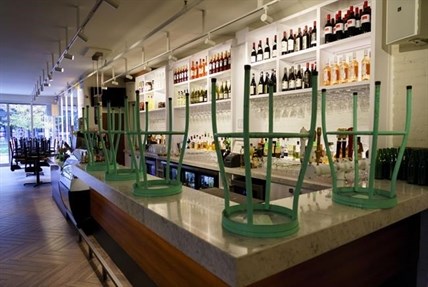
FILE. Restaurants across the country fight to survive.
Image Credit: THE CANADIAN PRESS/Paul Chiasson
March 20, 2021 - 11:10 AM
TORONTO - As pandemic restrictions loosened for restaurants in several Ontario regions Saturday, at least one infectious disease expert warned that allowing more people to dine indoors amid the COVID-19 pandemic's third wave could lead to so-called super-spreader events.
Dr. Andrew Morris, medical director of the Sinai Health System-University Health Network's antimicrobial stewardship program, said the Ontario government's decision to significantly increase restaurants' indoor capacity in two zones of its colour-coded pandemic response system at this time is "baffling."
The risk of transmission grows when more people are indoors without masks, particularly given the presence of more contagious variants of the virus, Morris said.
"This is a disease that lends itself to so called super-spreading events, and super-spreading events occur when there's somebody who everyone else does not suspect is infected and contagious, but in fact they are, and they're in the presence of many other people," he said.
"And that's what opening up this dining will do... in the midst of a wave, you're increasing dramatically the likelihood that those events are going to occur."
The move will also likely further burden public health systems as the need for contact tracing increases, he said.
As of Saturday, food and drink establishments in regions in the province's second-strictest "red" category can increase capacity to 50 people indoors, up from the previous limit of 10.
Establishments in “orange” zones can now have 100 people indoors, twice the previous cap of 50.
Some restaurants in those zones were rushing to adjust to the new measures Saturday, saying it has been hard to keep up with the sudden and frequent changes.
Antonella Ceglia, general manager of the Ottawa restaurant La Roma, said staff spent Thursday cancelling reservations after the city was moved from the orange zone to the more restrictive red category, only to have to call everyone back to rebook the following day when indoor capacity was increased.
While customers have, by and large, been very supportive, some have also been confused by the rapid shift, Ceglia said.
The restaurant also had to quickly update its online reservation system to allow for more bookings, as well as figure out what to order from suppliers at a time when revenue is tight, she said.
"It takes a lot of planning, and in times when we could be doing other strategic things for our business, we're basically just reacting to rules and regulations that are being put forth by the government," she said.
"It's just been an emotionally draining, physically exhausting week. And we're just we're just tired....of being like the guinea pigs, we're just tired of having our lives and livelihoods experimented with, essentially."
Meanwhile, restaurants in Toronto and Peel Region were allowed to offer outdoor dining starting Saturday, even though the regions remain in the strictest "grey lockdown" category of Ontario's pandemic framework.
Morris, the infectious diseases specialist, said outdoor dining should be promoted over indoor service.
"I believe that we can safely have outdoor dining, I'm really supportive of Toronto and other places having outdoor dining, we should absolutely have that with fresh air and ventilation," he said.
Premier Doug Ford announced the rule changes Friday, touting them as a means to support economic recovery.
Several restaurants and bars in Toronto vowed to reopen their patios Saturday as the city experienced sunny, spring-like weather.
The loosening of restrictions came with a caution from Dr. David Williams, the province's chief medical officer of health, who noted that Ontario has entered a third wave of infections with more contagious variants spreading.
He said people must remain vigilant and continue to practice protocols such as mask wearing, hand washing and physical distancing.
Ontario reported 1,829 new cases of COVID-19 on Saturday, as well as 11 deaths related to the virus.
Health Minister Christine Elliott said 593 of the most recent infections were in Toronto, 287 were in Peel Region, 157 were in York Region, 124 were in Hamilton and 101 were in Ottawa.
Provincial data showed 765 people were in hospital due to COVID-19, including 302 in intensive care units and 189 on ventilators.
More contagious variants linked to severe waves of infection around the world now make up about 40 per cent of cases in the province.
News from © The Canadian Press, 2021